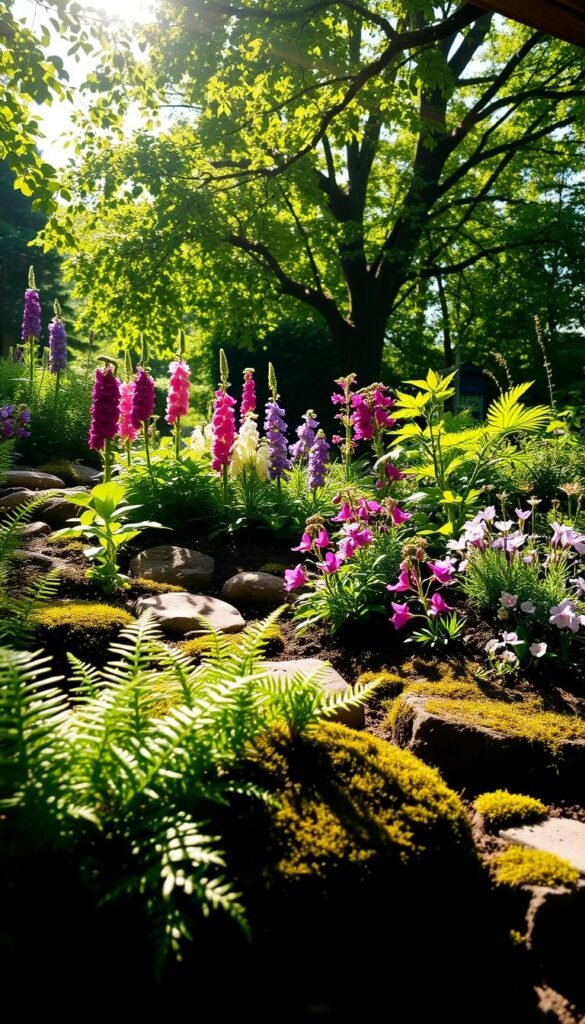Designing miniature landscapes offers endless creative possibilities, but success starts with understanding your environment. Whether your setup basks in sunlight or nestles under trees, selecting properly sized greenery ensures your decorative elements remain the star attraction. This balance keeps your display lush without overwhelming delicate structures.
Light exposure dramatically impacts growth patterns and plant health. Sun-loving varieties often feature vibrant colors and compact forms, while shade-tolerant options typically boast richer foliage textures. Our comprehensive plant list reveals specific species that maintain ideal proportions through different seasons.
A common pitfall involves choosing specimens that outgrow their designated spaces. Through careful selection, you’ll create visual depth using contrasting leaf shapes and strategic placement. This approach highlights miniature pathways and architectural details rather than hiding them.
Discover how to mix textures and growth habits for year-round appeal. We’ll explore maintenance tips that preserve your landscape’s magic while accommodating seasonal changes. With thoughtful planning, your creation becomes an evolving masterpiece that captures imagination at every glance.
Introduction to the World of Fairy Gardens
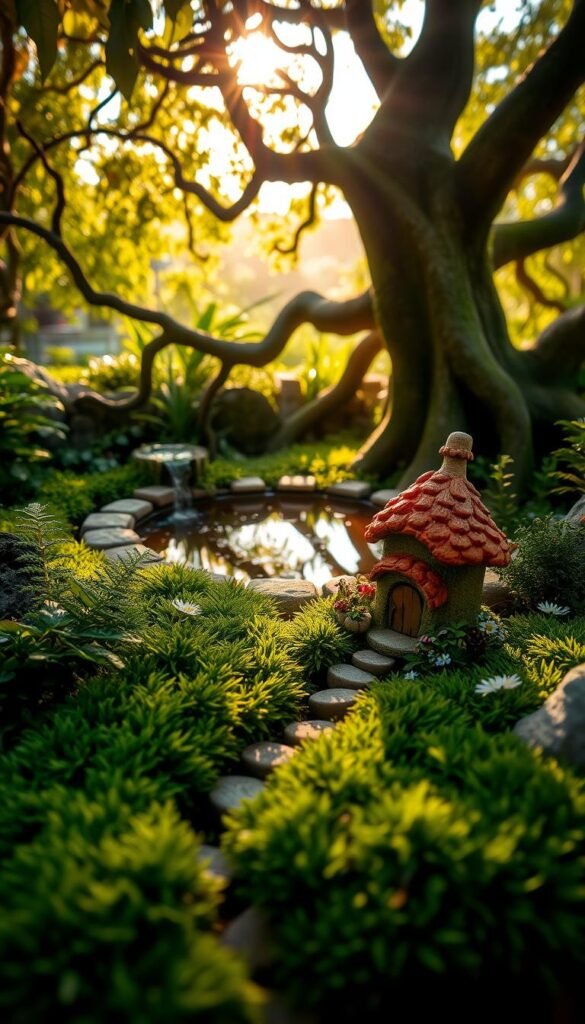
Discover the charm of crafting pint-sized worlds that spark joy and wonder. These tiny realms blend gardening creativity with storytelling magic, letting you design scenes straight from folklore. Whether tucked in a corner or displayed indoors, they transform ordinary spaces into imaginative escapes.
What Makes These Mini Realms Special
It’s not just about size—it’s the way these spaces whisper stories. Tiny bridges, miniature cottages, and pebble paths invite viewers to imagine hidden narratives. Studies show tending small-scale landscapes reduces stress by 34%, making them perfect for mindfulness practice.
Choosing Plants for Tiny Ecosystems
Selecting greenery requires precision. Ideal picks stay compact while adding texture and color contrast. Pair slow-growing varieties with seasonal bloomers for year-round appeal.
| Plant Type | Light Needs | Growth Habit |
|---|---|---|
| Irish Moss | Partial Shade | Groundcover |
| Miniature Thyme | Full Sun | Trailing |
| Dwarf Fern | Shade | Upright |
Parents love using these projects to teach kids about nature’s cycles. One school reported 68% increased student interest in biology after starting a classroom micro-garden. What will your tiny world inspire?
Getting Started with Your Enchanted Mini Garden
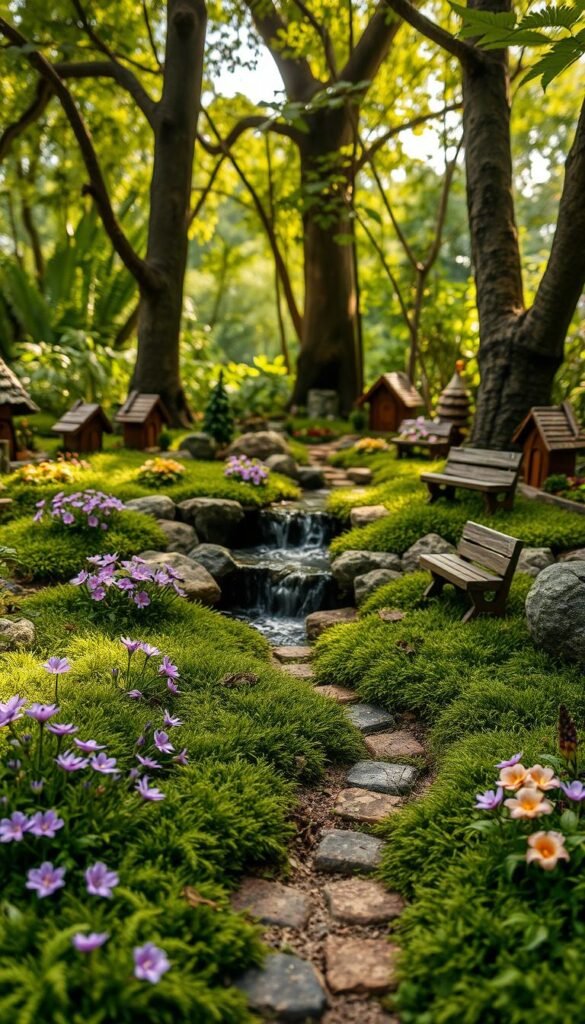
Building a captivating tiny realm requires thoughtful spatial planning. Start by sketching your vision – will it feature winding trails or a central gathering spot? This blueprint helps balance greenery with decorative accents like miniature benches or whimsical cottages.
Planning the Layout and Design
Begin with a three-to-five ratio – three ground-hugging varieties and two vertical elements per dwelling. Irish moss makes an excellent carpet, while dwarf boxwood adds structured height. Leave breathing room between specimens to prevent a cluttered look.
Taller greenery works best behind structures to mimic natural forests. Place flowering varieties near pathways where their colors pop against pebbles or mulch. For container setups, ensure your selections won’t outgrow their home within a single season.
Smart spacing creates functional magic:
• Frame entryways with trailing thyme
• Use creeping jenny as living pathways
• Reserve open areas for seasonal decorations
Remember: Your tiny landscape should tell a story. A cleared “meadow” beside a miniature well suggests daily use, while staggered heights imply depth. Leave expansion space for future additions – maybe a tiny vegetable patch or seasonal blooms.
Whether designing in a pot or garden bed, this approach ensures your creation evolves gracefully. You’ll maintain visibility of charming details while supporting healthy plant growth. Ready to bring your pocket-sized paradise to life?
Fairy Garden Plants that Thrive in Shade vs. Sun
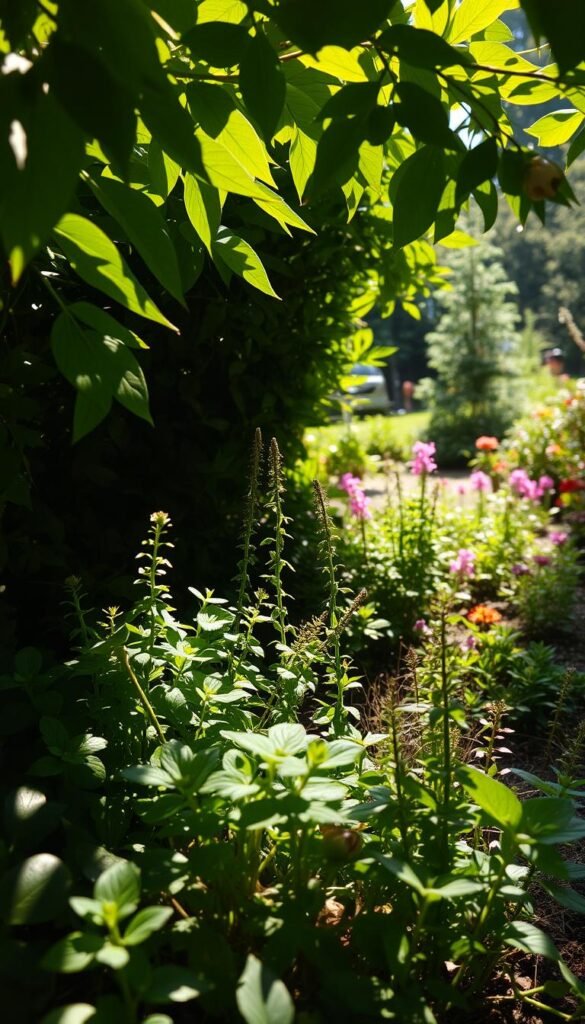
Light exposure shapes every magical scene you create. Start by observing your space at different times—note where sunlight lingers or retreats. This simple light mapping reveals which species will flourish naturally.
Sun-drenched spots demand resilient varieties. Creeping thyme forms aromatic carpets, while dwarf coreopsis adds golden accents. These choices handle heat without overshadowing miniature structures. In shaded corners, hostas unfurl patterned leaves that resemble tiny umbrellas, and astilbe offers feathery plumes for vertical interest.
| Plant Type | Light Preference | Key Feature |
|---|---|---|
| Sedum | Full Sun | Drought-resistant |
| Lungwort | Shade | Silver-speckled foliage |
| Miniature Roses | Sun/Partial Shade | Adaptable blooms |
Transitional zones where light shifts? Try sweet woodruff. Its star-shaped flowers brighten changing conditions. For stubborn areas, modify light with sheer curtains for containers or reflective stones to boost brightness.
Matching species to their ideal environment reduces upkeep. You’ll spend less time nursing struggling greenery and more time enjoying your living artwork. Remember—happy plants make enchanting displays that last seasons.
Sun-Loving Fairy Garden Plants
Bright sunlight transforms tiny landscapes into vibrant displays of color and texture. Choosing varieties that flourish under direct rays ensures your creation stays lively through summer’s heat. Focus on compact growers with built-in resilience to keep maintenance minimal while maximizing visual impact.
Practical Plant Picks for Bright, Sunny Spots
Creeping thyme carpets pathways with fragrant greenery, releasing herbal scents when touched. Sedum varieties like ‘Dragon’s Blood’ add jewel-toned foliage and star-shaped blooms that handle drought effortlessly. For classic charm, miniature roses offer delicate petals in shades from blush pink to crimson.
Lavender’s purple spikes attract pollinators while repelling pests naturally. Pair these with dwarf coreopsis for golden accents that bloom nonstop. If you prefer low-maintenance flowers, marigolds and petunias deliver cheerful hues without demanding constant attention.
Tips for Maximizing Sunlight in Your Garden
Position taller specimens like lavender on the west side to cast afternoon shade over delicate neighbors. Use reflective elements like white pebbles to bounce light onto lower-growing greenery. Rotate containers weekly to ensure all sides receive equal exposure, preventing lopsided growth.
Group heat-loving varieties together to create microclimates that boost humidity. This trick helps tender plants like miniature roses thrive even during dry spells. With smart placement, your sun-drenched display becomes a self-sustaining ecosystem of beauty.
Shade-Friendly Fairy Garden Plants
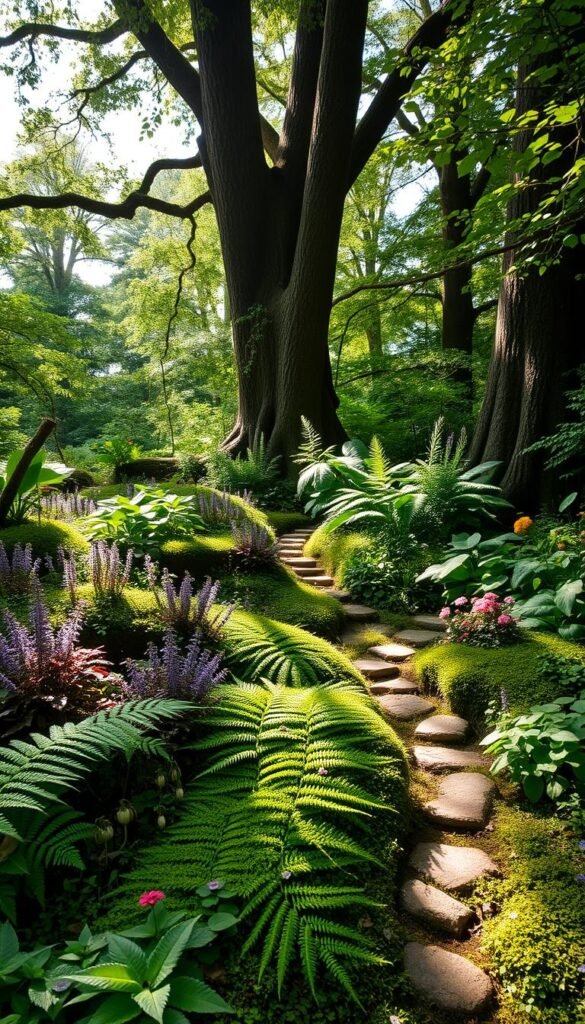
Dim corners transform into magical hideaways with the right greenery. These selections thrive where sunlight peeks rather than pours, creating depth and intrigue in shadowy spaces. Focus on foliage diversity to maintain visual appeal even without constant blooms.
Best Choices for Low-Light Areas
Baby tears form velvety carpets perfect for moonlit glades. Pair them with heuchera’s rainbow leaves for pops of plum or lime. Spike moss adds lacy texture, resembling tiny fern forests when clustered around miniature benches.
| Plant | Light Needs | Special Features |
|---|---|---|
| Astilbe | Partial Shade | Feathery pink plumes |
| Sweet Woodruff | Full Shade | Vanilla-scented leaves |
| Lungwort | Dappled Light | Silver-spotted foliage |
Hostas offer endless leaf variations—try ‘Mouse Ears’ for dollhouse-scale charm. For vertical interest, unique shade-loving varieties like dwarf ferns create natural canopies over tiny stone paths.
Creating a Cool and Enchanted Nook
Layer heights for depth: place taller ferns behind cottages and let creeping jenny spill over walkways. Add reflective elements like mirrored pebbles to brighten dark corners naturally.
Fragrant options like sweet woodruff engage multiple senses. Combine textures—glossy hosta leaves beside fuzzy lamium—to craft tactile wonderlands. For container setups, use light-colored pots to contrast with deep green foliage.
Selecting the Right Groundcover for Your Fairy Garden
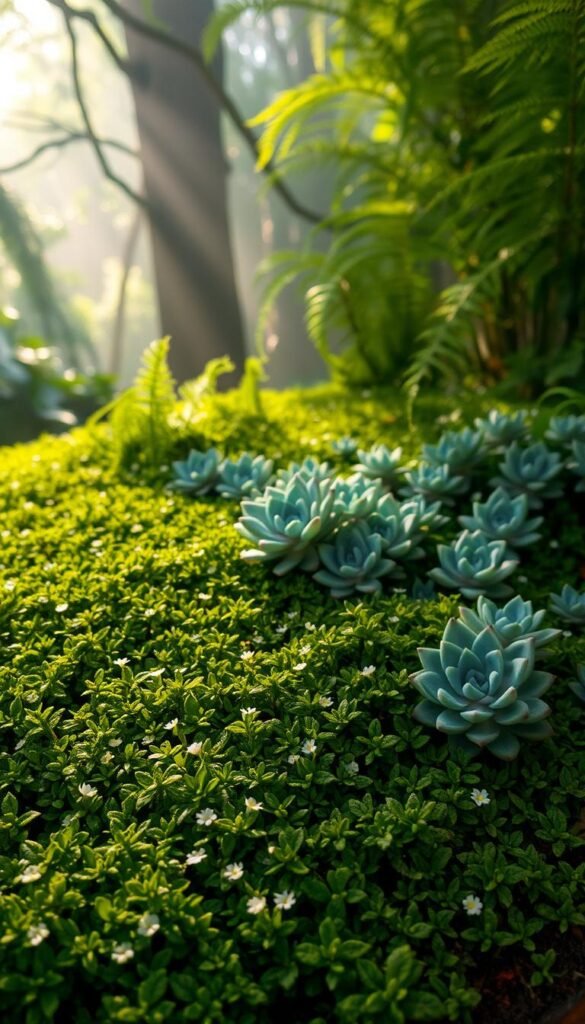
A lush carpet of greenery transforms miniature scenes from sparse to storybook-ready. These living foundations soften edges and create natural-looking settings for tiny structures. Without them, accessories like cottages or benches appear floating in bare soil.
Moss Magic and Creeping Wonders
Irish moss forms emerald cushions perfect for woodland paths. Its velvety texture mimics enchanted forests at dollhouse scale. Scotch moss adds sparkle with pearl-like blooms, ideal for moonlit meadow effects.
For dynamic movement, try creeping thyme. This aromatic spreader releases herbal scents when brushed and attracts pollinators. Its purple flowers peek through leaves like confetti at a fairy tea party.
| Groundcover | Style | Special Feature |
|---|---|---|
| Moneywort | Trailing | Golden leaves |
| Miniature Ivy | Climbing | Slow growth |
| Baby’s Tears | Carpet | Glossy foliage |
Fragrant varieties add sensory magic. Thyme’s citrusy aroma intensifies when stepped on, while sweet woodruff offers vanilla notes. These scents make your creation feel alive, even at pocket-sized scale.
Match textures to your theme: velvety mosses suit cottagecore designs, while moneywort’s trailing stems enhance whimsical containers. For structured looks, trim thyme into neat borders around pebble patios.
Small Stature Plants Perfect for Miniature Magic
Petite plants form the backbone of enchanting miniature displays. Their compact growth habits ensure your tiny structures remain visible while adding natural charm. Let’s explore options that deliver big personality in small packages.
Dwarf Flowers and Compact Greenery Options
Miniature daisies bring classic charm with quarter-sized blooms. Pair them with floss flowers for pops of blue resembling tiny fireworks. Coleus steals the show with vibrant leaves in ruby red and lime green—no flowers needed.
| Plant | Key Feature | Light Preference |
|---|---|---|
| Dwarf Marigold | Pest-repelling blooms | Full sun |
| Lily of the Valley | Fragrant white bells | Shade |
| Sun Patiens | Rainbow colors | Sun/Shade |
| Baby Tears | Velvety carpet | Indirect light |
For layered interest, combine upright growers like dwarf snapdragons with trailing thyme. This creates depth without overcrowding. Choose varieties like Japanese painted fern for year-round foliage that shifts from silver to burgundy.
Smart selections reduce pruning while maximizing visual impact. Petunias bloom nonstop in sunny spots, while sweet alyssum spills over edges like living lace. Rotate seasonal stars like miniature cyclamen to keep your scene fresh through autumn frosts.
Char
Crafting your own pocket-sized paradise becomes an adventure in balance and imagination. By matching greenery to your space’s light patterns, you ensure every tiny detail shines. Sun-kissed corners glow with drought-tolerant gems, while shaded nooks flourish with velvety foliage that whispers mystery.
Remember: contrasting textures add depth without clutter. Pair feathery ferns with glossy groundcovers, or let trailing vines soften miniature stone walls. Seasonal swaps keep displays fresh—try snow-dusted moss in winter or blooming succulents for summer charm.
Your creation evolves with care. Trim overenthusiastic growers to maintain clear sightlines to whimsical accessories. A weekly check for thirsty specimens prevents wilted drama. Most importantly, let your story guide the design—whether it’s a hidden woodland glen or a sunny cottage retreat.
With thoughtful choices and playful experimentation, these tiny worlds become living art. They invite pause, wonder, and endless reinvention. What tale will your landscape tell next?

